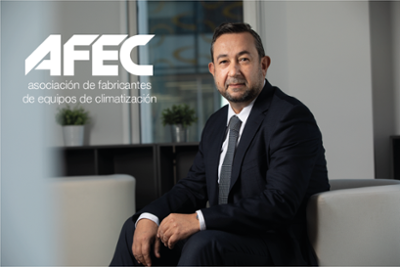

Francisco Perucho: C&R 2025 will be the unmissable event for the HVAC sector in Spain

In this interview, Francisco Perucho, Chairman of AFEC (the Air Conditioning Equipment Manufacturers Association), highlights the technological evolution of smart and efficient air conditioning, driving the development of increasingly advanced measurement, sensor, regulation and control systems; and sets out the main challenges facing manufacturers in the sector, as well as regulatory changes. In addition, as Chair of the Organising Committee of the C&R 2025 exhibition, to be held from 18 to 21 November at IFEMA MADRID, he encourages the public and professionals "to participate in the biggest event and meeting point for the HVAC sector, where supply and demand connect".
What are the main challenges for the HVAC industry in 2025 and beyond?
Some of today's challenges are a consequence of past events, or a hangover from the past. We could cite the impact of the economic climate; a summer in 2024 which, although hot, came late, thus delaying the expected upturn in the air conditioning season that would have boosted the year's sales performance; the challenges arising from the FGas regulation and its lack of consistency in some cases with the timing and requirements of eco-design regulations; a shortage of technicians and installers; the low rate of housing renovation; and very poor awareness of the vital need to improve ventilation and IAQ (indoor air quality), etc.
As well as these challenges inherited from previous years, we face others in a Europe we perceive as an ecosystem of interconnected risks, like the uncertainty arising from protectionist policies; geopolitical conflicts; market volatility; restrictive monetary policies; a European Union with less weight in the world order and that needs greater energy independence; climate and energy misinformation; electricity costs based on obsolete criteria that hinder the adoption of heat pumps, and more.
How should companies prepare themselves to meet these challenges?
Forecasts suggest the legislative tsunami that we saw begin more than a year ago from the European Union, with this over-accelerated and ambitious green crusade, will continue, leading us to believe that intense regulatory activity will continue, greatly impacting companies. In 2025 the key will be to anticipate, and rely on providing greater legal clarity and predictability.
Businesses continue to make a huge effort in resources, balancing the short and long term, between investment in innovation and development and sustainability, between training for future skills and excellence in new technologies, and so on. Companies also need to address new obligations, beyond the regulatory tangle: changes in working hours, lack of generational turnover and talent, electronic working hour records, electronic invoicing, back-to-office strategies, artificial intelligence and digitization (business cybersecurity and new working dynamics), etc.
What regulatory changes will affect the sector in the near future?
The complex web of regulations, legislative texts, requirements and demands of the European Union seeks the highest levels of safety and energy efficiency for all HVAC equipment on the market. However, as sustainability goes beyond these two parameters, Member States' legislators cover the other aspects with rules on durability, reparability, recyclability, environmental impact of the product, packaging or waste, among others.
Some of the most important regulatory changes at the moment are the evolution of the restrictions imposed by the FGas Regulation, the proposed regulation on the Net Zero Emissions Industry (with the aim of strengthening the European manufacturing capacity of net zero technologies), the Environmental Product Declaration, the taxonomy, the new cybersecurity and grid connection codes and the overhaul of the design of the electricity market.
Another important element of change is the EPBD (Energy Performance of Buildings Directive), which includes significant developments in terms of energy certification, automation and control system requirements, ventilation and IAQ requirements in order to improve indoor air quality, and a National Building Renovation Plan (PNRE 2026) on which we are already working.
What do you make of the latest smart air conditioning solutions?
AFEC would like to highlight the technological evolution of smart and efficient air conditioning, which is driving the development of increasingly advanced measurement, sensing, regulation and control systems; we are confident that 2025 will see a growth in these solutions, hand in hand with new regulations and AI and IoT applications, as well as equipment for Data Processing Centres (DPC).
What other issues do you see as important in the sector?
We will also continue to provide as much support as possible to increase the impact of the IDAE support programmes and MITECO's CAE (Energy Saving Certificate) incentives, and facilitate convergence with the energy sector (e.g. by updating the primary energy factor), to encourage the use of renewable and highly efficient heat pumps and energy recovery systems, which contribute to decarbonisation targets.
As well as serving as Chairman of AFEC, you are Chair of the Organising Committee of C&R 2025, to be held from the 18 to the 21 of November at IFEMA MADRID. How important will the event be and why would you encourage professionals and the public to attend?
We would like to underline the need for exhibitors and visitors alike to attend this unmissable event for the HVAC sector in Spain that is C&R 2025. A strong trade fair is a must for a strong sector. It’s in our hands to bring the HVAC industry to a position where it receives even greater recognition from Public Administrations and society at large: collective effort and support has a multiplier effect. It's time for all stakeholders to show a strong and clear commitment.
That's why we’re encouraging you to actively participate in this year’s C&R International Fair in November. It’s the biggest event and meeting point for our sector, where supply and demand are connected: manufacturers, energy communities, engineering companies, public administrations, distribution and marketing companies, federations, plumbing companies, technicians, installation companies, property administrators, facility managers, institutions, academics, construction companies, designers, certification companies, associations, assembly and maintenance companies, official bodies, service providers, architects, warehousing companies, developers, consultants, legislators, trainers, confederations, etc. can all share their experiences, knowledge, solutions and vision of the future with the air conditioning, refrigeration, ventilation and plumbing industry, as well as with other sectors such as catering, distribution, tourism, construction, hotels, education and architecture, among others.




